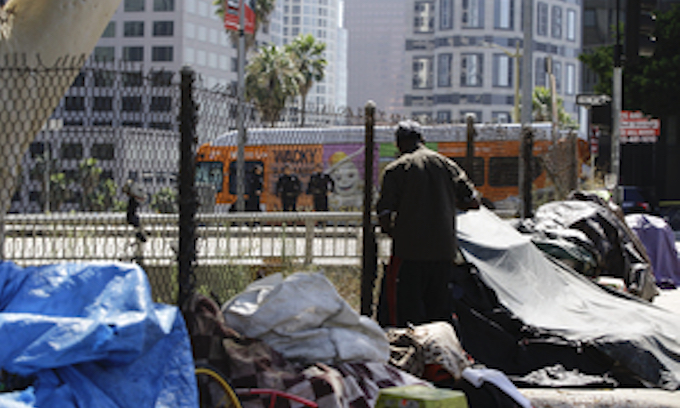Lauren Justice could tell the 19-year-old man holding most of his belongings in a backpack slung over his shoulder was high as he approached her near the corner of Beach Boulevard and Ball Road in Anaheim. She revealed her own past experience dealing drugs while living in an encampment near the Santa Ana Civic Center as they chatted over the sound of passing traffic.
“I was you,” the caseworker told him.
It didn’t take long before he trusted Justice enough to say he was using fentanyl. That’s about when she noticed Serenity, his daughter’s name, tattooed across the right side of his neck.
“It’s that kind of stuff that you try to forget about so you don’t feel as bad about the situation you’re in,” Justice said, recalling her own struggles with homelessness and substance abuse.
Justice was shouting at herself in the restroom of a courthouse before relinquishing her child into the custody of a family friend in 2015. She went through years of treatment and support before finding a way to become a part of her son’s life again.
She told the young homeless man his girl definitely wants to see her dad again. He called Justice about two weeks later, and asked about getting into rehab and shelter.
Justice is a lead caseworker for City Net Homeless Outreach, which has been connecting the unhoused in Anaheim to support services and shelter since 2014. She is also a member of the city’s Community Care Response Team (CCRT), which is run by the nonprofit.
The unarmed CCRT teams are the key component of a pilot program paid for by the federal Coronavirus Aid, Relief, and Economic Security (CARES) Act. The $2.5 million program approved by the Anaheim City Council last December currently requires no funds from the city’s budget.
Like Project Roomkey and similar initiatives covered by the CARES Act, the CCRT’s mission is, in part, to prevent COVID-19 from spreading unchecked among the homeless. It aims to do so by bringing medical and social services directly to people living on the streets and guiding them to some form of housing.
The program includes funding to hire more caseworkers. It also enhances City Net’s existing outreach teams in Anaheim with the addition of medical and mental health staff, and unarmed security specialists. They, rather than police, have been responding to reports of nonviolent situations involving people living on the street or suffering with mental health conditions since the beginning of 2021.
The pilot program is scheduled to run for six months. Its future will be decided by a coming review by city leaders.
The response teams currently work from 7 a.m. to 9 p.m. each day. These crews have taken on the role previously tasked to the Anaheim Police Department’s Homeless Outreach Team, APD Sgt. Shane Carringer said. The three officers who staffed that detail have been reassigned to the department’s Community Policing Team.
Hundreds assisted in getting into housing
The police outreach team helped over 400 homeless people get into some form of housing since it was formed in 2013. In comparison, the newly formed Community Care Response teams have helped 254 clients get into some form of housing in their first three months of operation.
There were 1,202 homeless people in Anaheim in 2019, according to the most recent data collected by the county. As of this month, as many as 596 were enrolled in case management with City Net.
“Every day, their number of street exits is growing,” City Net Chief Program Officer Jessica Bruce said.
Dispatch records show Anaheim police received 5,000 calls related to homelessness in 2013, Carringer said. The call volume skyrocketed to about 20,390 in 2020. Only a small fraction of those involved serious crime, Anaheim Police Chief Jorge Cisneros said.
In the first two months of the pilot program’s operation, police received 25 percent fewer calls regarding homeless people than they did during the same period last year, Cisneros said. He would like to see an even greater portion of the department’s calls diverted to the response teams, and believes there may be benefits in expanding the program to run 24/7.
As many as 298 of the 2,589 calls handled by the response teams from Jan. 1 through the end of March originated from Anaheim police dispatchers. Those would have taken officers about 30 minutes each, or roughly 149 hours, to handle, Cisneros said.
Another 1,260 of the response teams’ calls, just over 53 percent, came from people reaching out to their direct hotline. Those callers were mostly homeless people seeking services, Bruce said.
Looking for a place to stay
The police department’s Homeless Outreach Team was formed the same year a no-camping ordinance was implemented to deter people from pitching tents in Anaheim public parks. The law can be enforced so long as the city has shelter beds available, Cisneros said.
Officers tasked with moving people out of public spaces usually focused on trying to convince them to stay at shelters, Cisneros said. When they weren’t successful, they often managed to talk people into leaving without having to cite or arrest anyone.
Shakir Nuri has been homeless in Anaheim over two years, and said he prefers sleeping in his car. That’s partly because the likelihood of transmitting viruses is much higher in shelters. As many as 17 in Orange County have reported outbreaks of COVID-19 since last fall.
Terry Potts, 61, said he stays out of sight when people in uniform are around.
“They sweat ’em over there at Boysen (Park),” Potts said, while waiting at nearby Juarez Park near the 57 Freeway, north of Ball Road, as his twin brother, Tony, fried bacon over a portable stove. “They’re kicking them out over there.”
Terry Potts, a former Orange resident, said he has been homeless in and around Anaheim for about eight years. He said he struggles with a methamphetamine habit he picked up when he was 13, which now disqualifies him from most housing assistance programs.
Potts met Justice while conducting outreach in 2018. They’ve built a friendship, and she won’t give up hope he might overcome his addiction.
“Nobody is ever too far gone to recover,” Justice said. “It’s just a matter of finding the right people to bring you back to a better version of who you want to be.”
The time it takes before clients are willing to work with social workers and eventually connect with support programs varies dramatically on a case by case basis. And that breakthrough is only the first in a typically years-long process of finding a sustainable housing arrangement, City Net Vice President Matt Bates said.
A caseworker’s expertise
Eddie Dull, 55, of Anaheim, wound up in a hotel room paid for by Project Roomkey within an hour of meeting caseworker Machelle Jordan and clinician Madeleine Davis, members of the new response teams, in February. He fell to his knees, exhausted, while checking into the lobby of a Motel 6, following a day spent pushing a neatly arranged shopping cart filled with all of his belongings up State College Boulevard.
Dull was diagnosed with terminal pancreatic cancer two years ago. The motel stay allowed him to maintain a physical address long enough to qualify for state aid that will pay for housing and hospice care, Jordan said.
She realized Dull was a candidate for the assistance because she used to work with the California Department of Social Services. Years of experience and study of the aid available to the unhoused makes caseworkers better equipped than police to navigate the process of applying for that help, Cisneros, Bates and Anaheim City Councilman Jose Moreno said.
They all agree with advocates who say law enforcement officers were never meant to supplant the work of dedicated social service and mental health professionals.
People who have been evicted from their makeshift homes, burdened with tickets for camping in public or cited for sleeping in their cars by officers carrying badges and guns are going to be put on edge by the presence of law enforcement, said attorney and advocate for the homeless Brooke Weitzman.
Instances of police brutality against unhoused people, like the fatal 2011 beating of Kelly Thomas by three Fullerton police officers, further widen the divide between them, Weitzman said.
And the fatal shooting of Kurt Reinhold in San Clemente on Sept. 23, 2020, by deputies assigned to the Orange County Sheriff’s Homeless Outreach Team, was a recent tragedy that gave her reason to question how much progress police and sheriff’s departments have truly made over the years.
Six months after that shooting, which remains under investigation, Orange County Sheriff Don Barnes announced the formation of the department’s Behavioral Health Bureau. It will be staffed by 60 deputies with experience engaging with the unhoused population and who will handle calls involving homeless people.
Reinhold’s killing at the hands of law enforcement, like the deaths of George Floyd, Breonna Taylor and others in 2020, sparked a nationwide conversation about “defunding the police.” The concept encourages diverting funding from law enforcement agencies to support community initiatives, like aid for the unhoused, Cisneros said.
Spending priorities
It’s unlikely lawmakers in Anaheim would support dismantling the city’s Police Department, Moreno said. But two thirds of Anaheim’s budget is spent on police and Fire Department expenses. He believes it may be in residents’ best interest to question city spending priorities.
“Public safety shouldn’t just be about police and fire,” Moreno said. “It has to be about community parks and services. It has to be about social services to those in need dealing with homelessness or addiction.”
The early success of the city’s pilot project suggests law enforcement cannot be the only tool used to fix Anaheim’s problems, Moreno said. Solving those may require a shift in the way people have traditionally defined public safety.
The city’s plan to rely on unarmed intervention teams is modeled after programs like CAHOOTS (Crisis Assistance Helping Out On The Streets) in Oregon, and is the first of its kind in Orange County, Bates and Cisneros said. Other local governments are monitoring the effort as they review their strategies for the unhoused; and there’s some hope of expanding the strategy on a regional basis.
Weitzman called Anaheim’s program a step in the right direction, but said “it isn’t going to solve homelessness.”
“Only housing can do that,” Weitzman said.
___
(c)2021 The Orange County Register (Santa Ana, Calif.)
Visit The Orange County Register (Santa Ana, Calif.) at www.ocregister.com
Distributed by Tribune Content Agency, LLC.
—-
This content is published through a licensing agreement with Acquire Media using its NewsEdge technology.



















Yep, let the taxpayers pay for the stupidity of people that take drugs and destroy their lives. If one looks at whom the majority of drug addicts are, they are liberals, not Conservatives. They should do, what they do in Singapore. Twenty one months of rehab. Once the former addict gets a job, after rehab, they pay back the taxpayer for the expense of rehab. If they refuse rehab, they go to prison.
Hey Backpacker, I like the history lesson.
AND if they OD< those in singapore DO NOT SPEND hundreds of TAX PAYER DOLLARS< to save their sorry butts.
“That’s about when she noticed Serenity, his daughter’s name, tattooed across the right side of his neck.”
Absentee dads who tattoo their neglected child’s name on their bodies don’t impress me as being all that caring. They always have it where it can be seen, affording an opportunity to express how cruel life has been to them when someone inevitably notices it.
You want to remember your child and honor them? Get off that **** and clean up. But no, a tattoo is much easier. You get to lay back, relax, and a few hours latter all that concern has been taken care of.
You have a tat. A memorial to what could have been. You could have been the greatest man to live to the one person (victim) who mattered. Traded your own child for drugs and a buck’s worth of ink.
I wonder, how much Child support he’s ever paid? IF any.